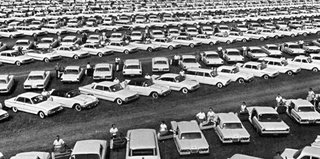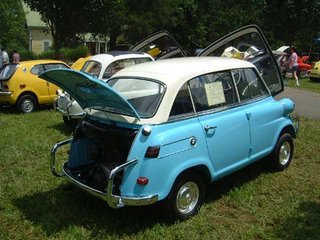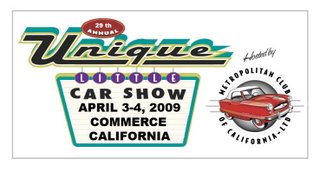
When I first saw photos tagged with the line ‘Help identify this Mystery HMod,’ on the Hmod yahoo group, I immediately thought: Crosley Special. Even though the car was reputed to have last been run with a Renault engine, the scale and style of it screamed Crosley. That’s one thing about dealing with cars that are only 4 feet wide— there aren’t many other cars that match their specs.

The car looked pretty rough. The fiberglass body had surprisingly little damage for a race car, but a mammoth okie hoodscoop had ruined the hood and an odd setback in the dash around the steering looked like an ill advised later modification. Many parts, including the engine and transmission, appeared to be missing. Prominent ‘DSR’ decals (D Sports Racing, the late sixties successor to the then defunct H Modified Class) indicated that the car was being set up for the track at some point after the mid sixties.
Despite the flaws, I was fascinated. Especially intriguing was the frame: a handbuilt tube ladder assembly that would have been woefully out of date by 1960 or so, indicating an early to mid-fifties build, matching the D-Type jag style body. Another point of interest was the rear end—a Halibrand-like quick change mated to what appeared to be a Crosley rear axle. And it was hard to tell from the pics, but the axles appeared to connect to tiny finned aluminum brake drums.
 An old racer named Carl Kapp had posted the car on the site to help the widow of a friend find a buyer for her late husband’s derelict race car. It had been sitting, partially disassembled, since at least 1973, and hadn’t been driven since sometime in the sixties. Kapp’s friend, a Chicago racing enthusiast named Leo Lowy, had owned the car since at least the mid sixties when Kapp met him. It wasn’t running even back then. Lowy and Kapp both ended up in California a decade later, Lowy with the car in tow. He died in 2002 and his widow told Kapp that the car had never been out of storage since they’d moved to Cupertino in 1973.
An old racer named Carl Kapp had posted the car on the site to help the widow of a friend find a buyer for her late husband’s derelict race car. It had been sitting, partially disassembled, since at least 1973, and hadn’t been driven since sometime in the sixties. Kapp’s friend, a Chicago racing enthusiast named Leo Lowy, had owned the car since at least the mid sixties when Kapp met him. It wasn’t running even back then. Lowy and Kapp both ended up in California a decade later, Lowy with the car in tow. He died in 2002 and his widow told Kapp that the car had never been out of storage since they’d moved to Cupertino in 1973.I called Lowy’s widow and made arrangements to see the car. David Brodsky, president of the West Coast Crosley Club and and onetime owner of several Hmods, agreed to meet us since he lived close to the car. I know quite a bit about stock Crosleys, but my knowledge of sportscars, especially homebuilts is pretty spotty, so I was really glad to have his expertise.
The car was pretty much as indicated in Ms. Lowy’s photos. I took measurements at the wheels, and the car turned out to have the same wheelbase/track as a Crosley Hotshot, supporting the idea that the car had Crosley origins. The front axle was late Crosley as was the steering, and the rear axle appeared to be from a Crosley roadster. Some parts- the wheels, belly pan and plumbing, actually looked better than they had in the pictures.

I asked about the many missing parts, and was told that some might be in the garage. Since it was filled floor to ceiling with storage boxes, car parts and home remodeling projects, I could barely get in the door. With my flashlight I could make out some car stuff on and under a workbench. As I squeezed in as far as I could, I spotted what i assumed was the Renault engine on the back floor and what appeared to be a way-too-big transmission under the bench. Moving what I could get to on the workbench, I found a tub containing a wiring harness-- topped with a gauge cluster. Two still-taped-for-racing foglights rested nearby. I started to get really excited, realizing that most of the missing parts were probably buried somewhere. The thing that really concerned me was the driveshaft- there didn't appear to be any spot in the garage long enough to accommodate one-- and this would have had to have been specially designed for the car.

It was getting dark and Ms. Lowy was ready for us to go. I asked her if she had decided on a price, and she said that she was going to consult with Carl Kapp once people had made offers. I told her that I’d talk to him about the parts I’d seen and send him the photos so that he could use them to figure out a fair price—and that I’d like to buy the car if I could afford it.
“Whole lotta work- that’s a big project.”
Fair enough. He's restored everything from Crosleys to Allards, so he oughtta know. I asked what he thought it might be worth.
“Well… honestly?... I wouldn’t take it if you gave it me.”
We both laughed, for different reasons, I’m sure.

 Dave "Smith" and I zipped down to SF this morning for the annual Arcane Auto Society show at Cowden Motors. The club is open to just about anything 'odd', and members own everything from Crosleys (that's West Coast Club President David Brodsky's teal '47 vert above) to Amphicars to homebuilts. If Average Joe on the street scratches his head when it drives by, it's probably eligible for Arcane membership. And 'driving by' seems to be a key- I don't think any car at the show was trailered.
Dave "Smith" and I zipped down to SF this morning for the annual Arcane Auto Society show at Cowden Motors. The club is open to just about anything 'odd', and members own everything from Crosleys (that's West Coast Club President David Brodsky's teal '47 vert above) to Amphicars to homebuilts. If Average Joe on the street scratches his head when it drives by, it's probably eligible for Arcane membership. And 'driving by' seems to be a key- I don't think any car at the show was trailered. There were a lot of neat cars there, but if I had to pick a favorite, it might be this 1957 Fiat wagon. The styling is clean and concise with just a hint of strangeness- note that third headlight in the center. It was an immaculate car, and the color combo was perfect. I didn't note the displacement, but I'm guessing 1200 cc.
There were a lot of neat cars there, but if I had to pick a favorite, it might be this 1957 Fiat wagon. The styling is clean and concise with just a hint of strangeness- note that third headlight in the center. It was an immaculate car, and the color combo was perfect. I didn't note the displacement, but I'm guessing 1200 cc. This Fiat 600 rolled in just after Dave and I got there. I have a real soft spot for these cars- if I hadn't gotten into Crosleys I'd have probably ended up with a 600... and I still might. My Dad had one of these before I was born, and watching the 8mm movie footage of him driving it on the sidewalks of 1963 Princeton, New Jersey is a cherished memory. The Fiat was the only European car besides Bugatti and Jaguar that my Dad didn't regard as a complete POS (which, given the reputation of fifties/sixties Fiats, still boggles my mind). He loved his, drove the snot out of it, and I wish he'd held on to it (along with the Bugatti, the '31 Ford Vicky, '51 Mercury and '72 VW bus) long enough for me to have at least had a ride in it.
This Fiat 600 rolled in just after Dave and I got there. I have a real soft spot for these cars- if I hadn't gotten into Crosleys I'd have probably ended up with a 600... and I still might. My Dad had one of these before I was born, and watching the 8mm movie footage of him driving it on the sidewalks of 1963 Princeton, New Jersey is a cherished memory. The Fiat was the only European car besides Bugatti and Jaguar that my Dad didn't regard as a complete POS (which, given the reputation of fifties/sixties Fiats, still boggles my mind). He loved his, drove the snot out of it, and I wish he'd held on to it (along with the Bugatti, the '31 Ford Vicky, '51 Mercury and '72 VW bus) long enough for me to have at least had a ride in it.  Dave didn't have a clear favorite, but he did keep wandering back to look at this Austin a lot. Truth be told, I stayed clear for fear that if I looked at it enough I'd decide I need one.
Dave didn't have a clear favorite, but he did keep wandering back to look at this Austin a lot. Truth be told, I stayed clear for fear that if I looked at it enough I'd decide I need one.






 One of the websites I check almost daily is the
One of the websites I check almost daily is the 
 1960 was a pretty good year for the US industry, IMHO. Sensible compacts like the Falcon and Valiant were introduced, and the fascinating, if flawed, Corvair entered the marketplace. An American automobile made in 1960 is still able to run comfortably in today's traffic, cruising at highway speeds and generally offering plenty of power. Brake systems may not match modern standards, but the drums of that day still work well, if not quite as well as today's discs. Certainly the same cannot be said for most European or Japanese products of the time. As much as I love Fiat 600s and early Datsuns, I'm not sure they would survive long on today's roadways.
1960 was a pretty good year for the US industry, IMHO. Sensible compacts like the Falcon and Valiant were introduced, and the fascinating, if flawed, Corvair entered the marketplace. An American automobile made in 1960 is still able to run comfortably in today's traffic, cruising at highway speeds and generally offering plenty of power. Brake systems may not match modern standards, but the drums of that day still work well, if not quite as well as today's discs. Certainly the same cannot be said for most European or Japanese products of the time. As much as I love Fiat 600s and early Datsuns, I'm not sure they would survive long on today's roadways.
 I'm stuck in Norcal this weekend, but you mid and south staters might want to head out to Commerce, CA to check out the
I'm stuck in Norcal this weekend, but you mid and south staters might want to head out to Commerce, CA to check out the 
